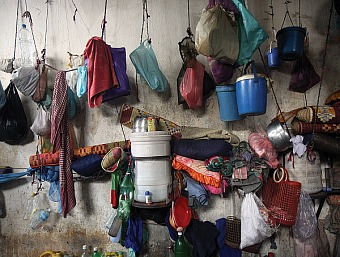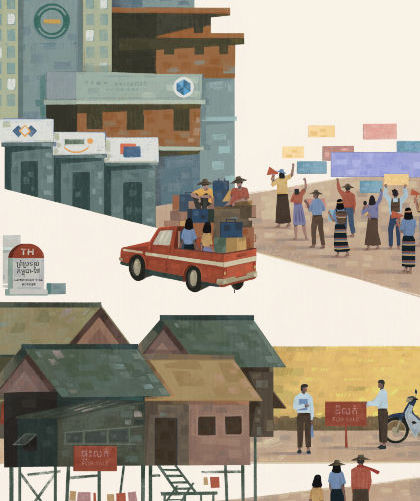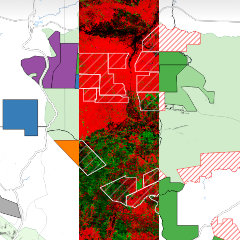Cambodian Prison Overcrowding Crisis Only Getting Worse
Published on 4 July 2011One year after LICADHO warned that Cambodia's prisons were in danger of becoming the world's most overcrowded, the country's inmate population continues to spiral out of control.
In late April 2011, Cambodia's total prison population stood at 15,001, a 12.6% increase over March 2010. That figure brought prison occupancy to 179%, keeping Cambodia's prison system among the 25 most overcrowded in the world. The system could overtake the top spot by 2019 if current trends continue.
The new data is detailed in LICADHO's most recent prison report, "Beyond Capacity 2011: A Progress Report on Cambodia's Exploding Prison Population," which will be released on July 4, 2011. The report updates LICADHO's 2010 prison overcrowding report, "Beyond Capacity: Cambodia's Exploding Prison Population and Correctional Center 4," which was published in July 2010.
"One year later, not much has changed," said LICADHO Director Naly Pilorge. "The pace of growth has slowed slightly, but virtually every other statistical indicator is worse: The prison population, the incarceration rate, the occupancy rate, and the growth projections. The criminal justice system continues to move backwards on this problem."
The root causes of prison overcrowding are myriad and complex, but no significant action has been taken to address them since LICADHO's last report.
Prison is still the default punishment, and pretrial detention is imposed as a matter of course. Some prisoners are held in pretrial detention beyond the time limits prescribed by law, while others are held in prison past the expiration of their sentences. Inmates in the midst of appeals proceedings are sometimes imprisoned beyond the maximum punishment prescribed for their crime, even if they were acquitted at the court of first instance. The 2009 Code of Criminal Procedure created a parole system, but it has yet to be implemented.
The report also highlights three new areas of concern that LICADHO has documented over the past year, including: The practice of imprisoning those who cannot - or do not - pay their criminal fines; a pilot program in which pretrial inmates were transferred to a local drug detention center to reduce prison overcrowding; and the use of prison sentences that are disproportionate to the crimes for which they are imposed. The latter concern is supported by a handful of case studies, including one in which a man was sentenced to a year in prison for stealing a chicken.
It appears that short prison sentences for minor crimes contributed significantly to the prison population's growth over the past year. The General Department of Prisons (GDP) reported that they processed 6,836 new admissions during 2010, a number which represented almost half the prison population.
"If the number of intakes was cut in half - via bail, alternative sentencing measures, or more judicious use of prosecutions - the prison population could have actually shrunk significantly in 2010," said LICADHO President Dr. Pung Chhiv Kek. "There is clearly some elasticity in the population; it's up to policymakers to exploit it."
Another concern highlighted in the report is the unreliability of Cambodia's prison capacity calculations. The GDP has never conducted a thorough nationwide survey of prison capacities; nor have they adopted a space-per-prisoner standard.
A proper accounting, which LICADHO recommends should take place this year, could reflect more overcrowding than previously reported. One prison that LICADHO visited, for example, was officially filled to about 155% of capacity. But LICADHO observed a series of cells that were filled to between 275% to 550% capacity when proper standards for minimum floor space were applied.
There is no official international standard for floor space per prisoner, but the International Committee for the Red Cross has stated that two square meters per person is the bare minimum, even in "exceptional crisis situations." Thousands of Cambodian prisoners live in cells with less than one square meter per person.
"Even if the calculations are revised downward by 25%, it would mean that Cambodia's prisons are actually filled to about 240% of their capacity," Pilorge said. "That would put Cambodia in top-10 territory, in terms of worldwide comparisons."
The final portion of the report reviews recommendations made in LICADHO's 2010 overcrowding report, and revises them in light of recent developments.
"The prison overcrowding crisis is far from over," Kek said. "And, unfortunately, as of right now, a solution is not even in sight."
For more information, please contact:
▪ Dr. Pung Chhiv Kek, President of LICADHO (French, English, Khmer) - 012-802-506
▪ Naly Pilorge, Director of LICADHO (French, English) - 012-803-650
▪ Ham Sunrith, Dep. Director of Monitoring & Protection, LICADHO (Khmer) - 012-988-959
PDF: Download full statement in English - Download full statement in Khmer







